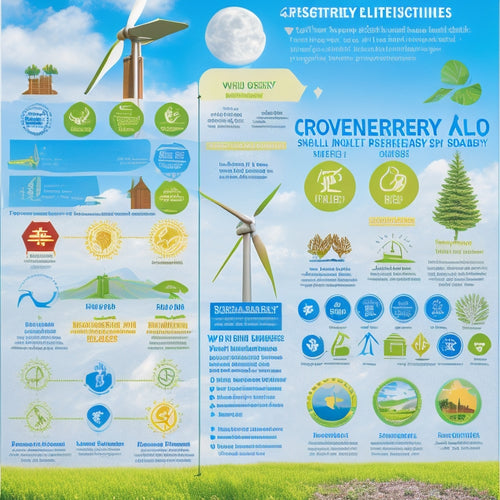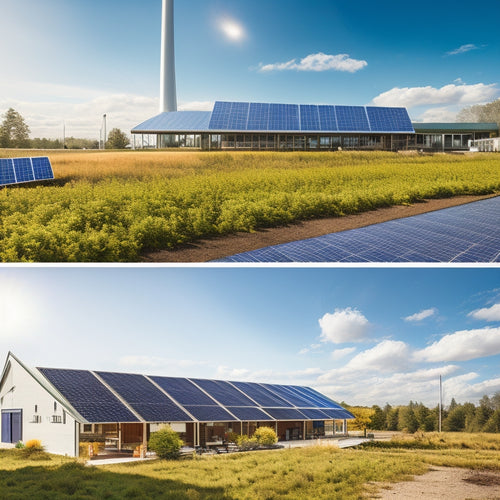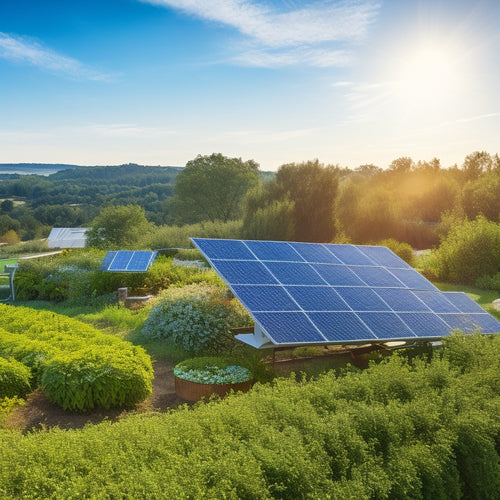
Average Commercial Installation Costs: Top 10 Insights
Share
You're likely to pay between $2.50 and $3.50 per watt for a commercial solar panel installation, with costs varying considerably depending on system size, panel quality, and roof complexity. Larger systems and high-efficiency panels increase costs, while regional installation costs can differ by up to 50%. Inverters, racking, and permits add to expenses, with potential additional fees for monitoring and maintenance. What's more, unique project requirements, specialized labor, and regional variations can drive up costs. As you navigate the complexities of commercial installation, understanding these factors can help you optimize your project and maximize ROI – and there's more to uncover.
Key Takeaways
• Larger system sizes and higher energy demands drive up installation costs, with prices increasing by $2.50 to $3.50 per watt for larger installations.
• High-efficiency Tier 1 panels increase installation costs by 15-25%, but offer higher energy savings over time, making them ideal for limited roof space or maximizing energy output.
• Inverters, racking, and tracking systems, as well as permits and inspections, account for significant additional installation expenses, ranging from $2,000 to $20,000 or more.
• Installation complexity, including integrating disparate systems and unique project requirements, can drive up expenses, especially when specialized labor, materials, and expertise are required.
• Regional cost variations can range by as much as 50%, with coastal areas, urban centers, rural areas, and extreme climate zones affecting installation costs differently.
System Size Affects Commercial Costs
As you consider commercial solar installation, it's important to understand how system size impacts costs. The larger the system, the more substantial the commercial installation costs, as a general rule, with prices increasing by $2.50 to $3.50 per watt as the system size grows from small to large-scale installations. This is because larger systems require more equipment, labor, and resources.
When scaling up a project, you'll face higher energy demands, which drive up costs. For instance, a 500-kilowatt system will be more expensive than a 100-kilowatt system. To optimize your project, it's vital to accurately assess your energy demand and select a system size that meets your needs. By doing so, you'll be able to better control your installation costs and maximize your return on investment.
Panel Quality Impacts Installation Prices
When you're considering commercial solar installation costs, you'll find that panel quality plays a significant role in the overall price tag. You'll need to weigh the benefits of high-efficiency options, premium brand pricing, and Tier 1 panel costs to make an informed decision.
Tier 1 Panel Costs
Your commercial solar panel installation costs will vary depending on the quality of the panels you choose, with Tier 1 panels being the most expensive due to their high-efficiency ratings and premium materials.
As a Tier 1 panel user, you can expect to pay around 10-15% more than mid-range options. This increased cost is largely due to the high panel efficiency of Tier 1 panels, which can reach up to 22% efficiency. In comparison, mid-range panels typically have an efficiency rating of 18-20%.
While the upfront cost may be higher, Tier 1 panels can provide a higher return on investment in the long run due to their increased energy production.
High-Efficiency Options
High-efficiency solar panels, boasting efficiencies of 20% or higher, come with a substantial price tag, pushing installation costs up by 15-25% compared to mid-range options. You'll pay more upfront, but high-efficiency panels can lead to greater energy savings over time.
They're a good choice if you have limited roof space or want to maximize your energy output. While the higher cost may seem challenging, high-efficiency panels can provide a higher return on investment in the long run. In fact, they can increase your energy savings by up to 20% compared to mid-range options.
If you're looking for a cost-effective way to reduce your energy bills, high-efficiency panels may be the way to go. Just be prepared for the higher upfront cost.
Premium Brand Pricing
How much are you willing to pay for prestige, as premium brand solar panels can increase installation costs by as much as 50% compared to standard options?
You're not just buying a product, you're buying a luxury appeal that comes with a hefty price tag. The marketing strategy behind premium brands focuses on exclusivity and high-quality materials, which translates to a higher cost per watt.
While they may offer better performance and durability, the question remains: is the added cost worth it for your business?
If you're looking to make a statement or want the best of the best, premium brands might be the way to go. However, if budget is a concern, standard options may be a more viable choice.
Weigh your options carefully and consider the trade-offs before making a decision.
Installation Complexity Adds Expenses
When you're planning a commercial installation, you'll quickly realize that complexity adds up fast - and so do the expenses. System integration challenges, for instance, can be a major hurdle, requiring specialized expertise and equipment that drive up costs.
Meanwhile, customized solution requirements can also inflate your bill, as unique needs demand tailored approaches that don't come cheap.
System Integration Challenges
As you navigate the complexities of commercial installation, integrating disparate systems can significantly drive up expenses, with even a single misconfigured component capable of triggering a costly cascade of errors.
You'll need to overcome data silos, where isolated systems fail to communicate effectively, leading to inefficiencies and added costs.
Additionally, integrating systems can also introduce cybersecurity risks, as vulnerabilities in one system can compromise the entire network.
To mitigate these risks, it's imperative to prioritize system integration, ensuring seamless communication between components.
By doing so, you'll minimize the likelihood of errors, reduce costs, and safeguard your commercial installation from potential security threats.
Effective system integration is vital to avoiding unnecessary expenses and ensuring a smooth, efficient installation process.
Customized Solution Requirements
Your commercial installation project's unique requirements often necessitate customized solutions, which can greatly increase costs due to the inherent complexity of tailored configurations. This is particularly true when your project demands specialized design elements, such as:
- Non-standard equipment sizes or shapes
- Unconventional installation locations (e.g., rooftops or historic buildings)
- Integration with existing, outdated systems
- Compliance with unique regulatory requirements
- Customized user interfaces or dashboards
These unique needs often require more labor, materials, and expertise, driving up costs.
Be prepared to invest in specialized design and installation services to meet your project's distinct requirements. By understanding these complexities, you can better plan and budget for a successful commercial installation project that meets your specific needs.
Roof Size and Shape Matters
The size and shape of your roof greatly impact the cost of a commercial solar panel installation. A larger or more complex roof design requires more materials and labor. You'll need to take into account roof obstacles like skylights, vents, and HVAC units, which can increase installation costs.
Additionally, you must adhere to local building codes, which can vary by region. These codes may dictate specific installation requirements, such as fire code regulations or wind load calculations, adding to the overall cost.
A larger roof with more complexities will require more labor hours, equipment, and materials, driving up costs. Understanding the intricacies of your roof's design will help you better estimate the costs of your commercial solar panel installation.
Commercial Inverter Costs Breakdown
Commercial inverters, a critical component of your solar panel system, account for around 10% to 15% of the total installation cost, with prices ranging from $2,500 to $10,000 or more, depending on the system size and inverter type.
When selecting an inverter, consider the following key factors to maximize your return on investment:
- Inverter efficiency: A higher efficiency inverter can lead to higher energy production and increased cost savings.
- Compatibility: Make sure the inverter is compatible with your solar panel system and local electrical grid.
- Warranty: Look for inverters with extensive warranties that cover parts and labor for an extended period.
- Monitoring capabilities: Choose an inverter with built-in monitoring to track performance and identify potential issues.
- Certifications: Opt for inverters with relevant certifications, such as UL or IEEE, to ensure safety and compliance.
Mounting and Tracking System Fees
Racking and tracking systems, which account for around 10% to 15% of total installation costs, can range from $2,000 to $5,000 or more, depending on system size and complexity.
You'll need to take into account the structural integrity of your building or installation site, as well as the soil composition, to determine the best type of mounting system for your commercial solar installation.
For example, if you have poor soil quality, you may need to invest in a more robust foundation system, which can increase costs. Additionally, tracking systems that adjust to follow the sun's movement can increase energy production, but also add to the overall cost.
Permits and Inspections Add Up
Your permit and inspection costs can add up quickly, ranging from $5,000 to $20,000 or more, depending on the complexity of your project and the jurisdiction in which you're operating. These costs are often unavoidable, as they're necessary to guarantee your installation meets local building codes and safety standards.
Here are some of the key factors that can drive up permit and inspection costs:
-
Code enforcement fees: These vary by jurisdiction, but can range from $500 to $5,000 or more.
-
Municipal fees: These can add up quickly, especially if you're working in a large city or densely populated area.
-
Inspection fees: You may need to pay for multiple inspections throughout the installation process.
-
Permit processing fees: These can range from $500 to $2,000 or more, depending on the complexity of your project.
-
Plan review fees: These can add an additional $1,000 to $5,000 or more to your overall costs.
Monitoring and Maintenance Fees
As you plan your commercial installation, you'll need to factor in the ongoing support costs that come with monitoring and maintenance fees. These fees typically involve a monthly structure, where you'll pay a set amount for regular system checks, software updates, and troubleshooting.
Understanding these fees is important, as they can add up quickly and impact your overall installation costs.
Ongoing Support Costs
Monitoring and maintenance fees, a substantial component of ongoing support costs, can add up to 15% to 20% to your annual commercial installation expenses. These costs are vital to guarantee your system runs smoothly and efficiently.
You'll need to budget for:
- Software upgrades to stay current with industry developments
- Regular system checks to prevent unexpected downtime
- Emergency repair services to minimize system downtime
- On-site technical support for complex issues
- Remote monitoring to identify potential issues before they occur
These ongoing support costs are essential to maintaining peak system performance and minimizing system downtime. By factoring these costs into your budget, you can avoid unexpected expenses and ensure your system runs smoothly and efficiently.
Monthly Fee Structures
When calculating your ongoing support costs, you'll need to take into account a monthly fee structure that covers monitoring and maintenance services, which can range from $500 to $5,000 per month, depending on the complexity of your system and the level of support required.
You'll typically encounter two types of pricing models: fixed pricing and tiered plans. Fixed pricing provides a predictable monthly cost, often preferred by businesses with straightforward system requirements. Tiered plans, on the other hand, offer flexible pricing based on the level of support needed, making them suitable for organizations with varying system complexities.
Battery Backup System Costs
You can expect to pay between $5,000 and $15,000 or more for a battery backup system, depending on the type, quality, and capacity of the equipment. This investment provides a reliable source of power during outages, guaranteeing your business remains operational.
When selecting a battery backup system, consider the following key factors:
- Battery Life: A longer lifespan means fewer replacements and lower costs.
- System Failures: Look for systems with built-in redundancy to minimize downtime.
- Scalability: Choose a system that can adapt to your growing energy needs.
- Efficiency: Opt for systems with high energy conversion rates to reduce waste.
- Monitoring: Ensure your system provides real-time monitoring and alerts for peak performance.
Regional Installation Cost Variations
Installing a commercial battery backup system can cost considerably more or less depending on the region, with prices varying by as much as 50% or more due to differences in labor costs, permitting requirements, and local building codes. When considering your installation, it is crucial to understand how regional factors impact costs.
| Region | Cost Variation |
|---|---|
| Coastal Areas | +20% (Coastal Premiums) |
| Urban Centers | -10% (Urban Incentives) |
| Rural Areas | -15% (Rural Discounts) |
| Extreme Climate Zones | +30% (Climate Zones) |
Keep in mind that these regional variations can significantly impact your overall installation costs. By understanding these factors, you can better plan and budget for your commercial battery backup system.
Frequently Asked Questions
Can a Single Solar Panel Be Used for Commercial Installations?
You can't use a single solar panel for commercial installations; it's inefficient. Instead, consider a system design that optimizes panel efficiency, combining multiple panels to achieve the desired power output and energy yield.
Are Energy Storage Systems Required for Commercial Solar Installations?
You don't necessarily need energy storage systems for commercial solar installations, but taking into account system sizing and backup power options can guarantee a reliable and efficient energy supply, especially during grid outages or peak demand periods.
How Often Should Commercial Solar Panels Be Cleaned and Maintained?
You'll be surprised to know that dirty panels can reduce energy output by up to 25%! To avoid panel degradation, you should clean and maintain your commercial solar panels every 6-12 months, following a strict maintenance schedule to guarantee peak performance.
Can Commercial Solar Installations Be Financed Through Loans or Leases?
You can finance commercial solar installations through loans or leases, accessing financing options that provide financial benefits, such as reduced upfront costs and predictable monthly payments, allowing you to control your energy expenses.
Are There Government Incentives for Commercial Solar Installations?
'You'll be interested to know that 70% of commercial solar installations are financed through third-party agreements. Fortunately, you can also tap into government incentives like 30% Tax Credits and Renewable Grants, greatly reducing your upfront costs.'
Related Posts
-

Renewable Energy Certifications for Businesses
Renewable energy certifications are essential for your business, showcasing your commitment to sustainability and enh...
-

Off-Grid Solar Solutions for Eco-Conscious Businesses
Off-grid solar solutions offer you a path to both sustainability and substantial cost savings. By adopting these syst...
-

Green Energy Alternatives for Independent Living
To enhance your independent living, consider green energy alternatives like solar panels and wind turbines. These opt...


